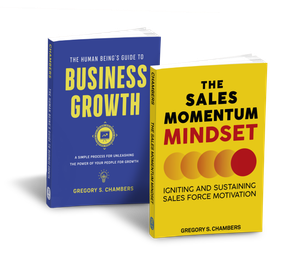Business Growth #187: Daydreaming, Troubleshoot sales cycles, Light fixtures

GREG'S RIGHT FIT NEWSLETTER #187
Quick notes to help you get more sales and marketing done in less time. . . next week.
In this issue:
- Techniques for FIT
- Being Human
- Random Stuff
Techniques for FIT
- With the recent spate of random fatalities in U.S. news, next week is a good time to ruminate on death. As Covey put it, let's begin with the end in mind. Project yourself on your deathbed and consider your legacy. Then take action.
- Ninety-nine out of a hundred of you reading this note are living in a world unimaginable to your predecessors. For instance, 100 years ago, the USA had 100MM people and 50% of them lived in rural areas. Take 30 minutes next week to consider what your descendants might experience.
- I think one of our human superpowers is the ability to daydream. It's shorthand for what I suggested in the death and descendants ideas. Daydreaming helps us get more done in less time next week because it helps us tackle complicated challenges. Let your mind do what it does best.
- We humans are the only creatures to make maps. When we share maps, we describe top down and ground level perspectives to the person we're helping. Your mentors do that too. When listening to them, split their advice into two levels. It speeds up understanding.
Being Human - Troubleshooting long sales cycles ------------------------------------------------------------
“
“It doesn’t matter which side of the fence you get off on sometimes. What matters most is getting off. You cannot make progress without making decisions.” —Jim Rohn

When sales cycles are longer than management wants and deals drag on and on, I am called in to troubleshoot the problem. I do this enough that I have a list of 10 steps I go through, so if you're dealing with this issue I'll share a few.
1. Troubleshoot new cycles, not old ones
Once a sales cycle is moving it's hard to change the direction. When troubleshooting, the temptation is to go back and get creative with current deals. The key is to change future sales cycles. Don't stress about what was missed in a current cycle. Approach the new cycles with the idea that you want Yes's or No's to happen faster. What's done is done, let it go.
2. Opportunity development
The bigger the promised outcome, the harder the prospect works to get the deal done. ROI in the minds of most sales people is new sales, cost savings, or time saved which are great, but they are lagging indicators and push ROI calculations down the road which adds time to the sales cycle. If I'm generating more leads, for instance, a company has to wait a year to see the impact on sales. . .making it harder to take immediate action.
Asking for leading indicators helps speed up sales cycles because it moves the prospect's ROI thinking closer to today. To use the same example, if more sales from the more leads is how the CFO will determine ROI, ask what early indicators will tell them they're on the right path. How will they measure early progress? How will they know it's working? It's not uncommon to get blank stares for these questions, so be prepared to help with language like, "other people in your situation, looking for the same results, look at X or Y. . ."
3. Decision Process Mapping
Once an opportunity is fully developed (which is the #1 way my clients bump sales) the next item to troubleshoot is understanding the client's decision process. In most companies there will be multiple buyers in a decision. Working with your contact to map the sales cycle speeds up the process. I have seen it referred to as "working the steps" because it's easy to think about decisions as steps in a process.
Start by having your buyer list the steps of the decision process. The language is simple, "tell me about the steps your company takes to make a decision like this." We don't ask our contact how THEY make a decision or WHO ELSE is involved - we start by listing the steps.
Step 1
Step 2
Step 3
Most companies haven't formalized a decision making process, so often this step is immensely useful to them.
Once we have their steps, we need to know what decision is made in each step. "Since these are the steps, let's talk about what decision is made in each step."
Step 1 - what decision?
Step 2 - what decision?
Step 3 - what decision?
Now it's time to ask who makes that decision in that step. Doing it in this order (steps, what decision, who makes it?) reveals more people, more buyers, you need to visit.
Step 1 - what decision? - who makes it?
Step 2 - what decision? - who makes it?
Step 3 - what decision? - who makes it?
You need to talk to all of the "who's" on your list because the fourth part of the grid is "and what criteria will they use to make the decision?" Will they just sit and think? Will they compare to competitors? Will they consult someone?
Step 1 - what decision? - who makes it? - how do they decide?
Step 2 - what decision? - who makes it? - how do they decide?
Step 3 - what decision? - who makes it? - how do they decide?
Besides working on opportunity development, working decision lists creates the second biggest jump in speeding up sales cycles (and it makes sales bigger, which is interesting).
4. Dig Into Resources
Sales cycles develop along these lines: identifying companies is first, identifying buyers is second, building opportunities follows etc. Here's the cycle I have in my head:

As you develop opportunities, it's natural to cover resources. There are 3 main kinds of resources - Money, People, Time - and most business development people focus their energy on money because it's important. I maintain that the speed of your sales cycle depends just as much on People and Time . . .because the secret in sales is there is always money. If the outcome is big enough, money always turns up. Over time, I've found the hardest parts of delivery are either people oriented or timing oriented. People refers to both internal and external workers, who is doing what? And timing is when the results need to happen. Sooner is harder, later is easier. Concentrating on people and timing resources as much as you focus on money will speed up sales cycles because it helps the prospect envision the outcome in clearer terms.
Those four are a good start.
If you find them helpful, good. If you have questions, ask. If it's stuff you already know, I'm happy to be a reminder.
Random Stuff
“My father worked in profanity the way other artists might work in oils or clay. It was his true medium, a master." -Ralphie as Adult, A Christmas Story

(easier to hang than the mine)
A few months ago I mentioned one of my handyman skills as "able to install light fixtures," thereby issuing a challenge to the universe.
My lovely bride sent away for a beautiful ceiling fixture that is made of dozens of petal like a flower, only more intricate. I'm sorry, they aren't just petals, they are capiz-lotus-petals and there are hundreds, not dozens. Anyway, my chore is simple. Install it.
Once the box opens, the universe starts giggling. There's a big sign on the fixture saying "WARNING!! FRAGILE!!" so I carefully take it out and turn the delicate fixture over and over in my hands, mesmerized by it's beauty. That's right before it comes loose from whatever I'm holding and crashes back into the box. No worries I think, no one's running up the stairs to check on my, and someone would have to look really hard to find the bent petals.
Next is attaching the bracket to the old house ceiling. "It's not a fit, you must get a new bit" sings Johnnie Cochran. That done, we're making progress but just how do you attach to the bracket when it's hiding under the cover which is pressed to the ceiling. . .while balancing on a step stool, sweating as the evening sun fires through the window? At least the cat enjoys chasing the light reflecting from my watch onto the wall.
I won't go on. Suffice it to say that when my lovely bride comes in to inspect the final product, the first thing out of her mouth is, "do you just cuss like that because of your Dad?"
It's true. My mentor is one of the best in the business. I take the comparison as a compliment.
"Hey," she says squinting and pointing to a corner of the fixture, "did it come like that?"
If you need to set up a time to visit, follow this link:
https://calendly.com/chamberspivot/





